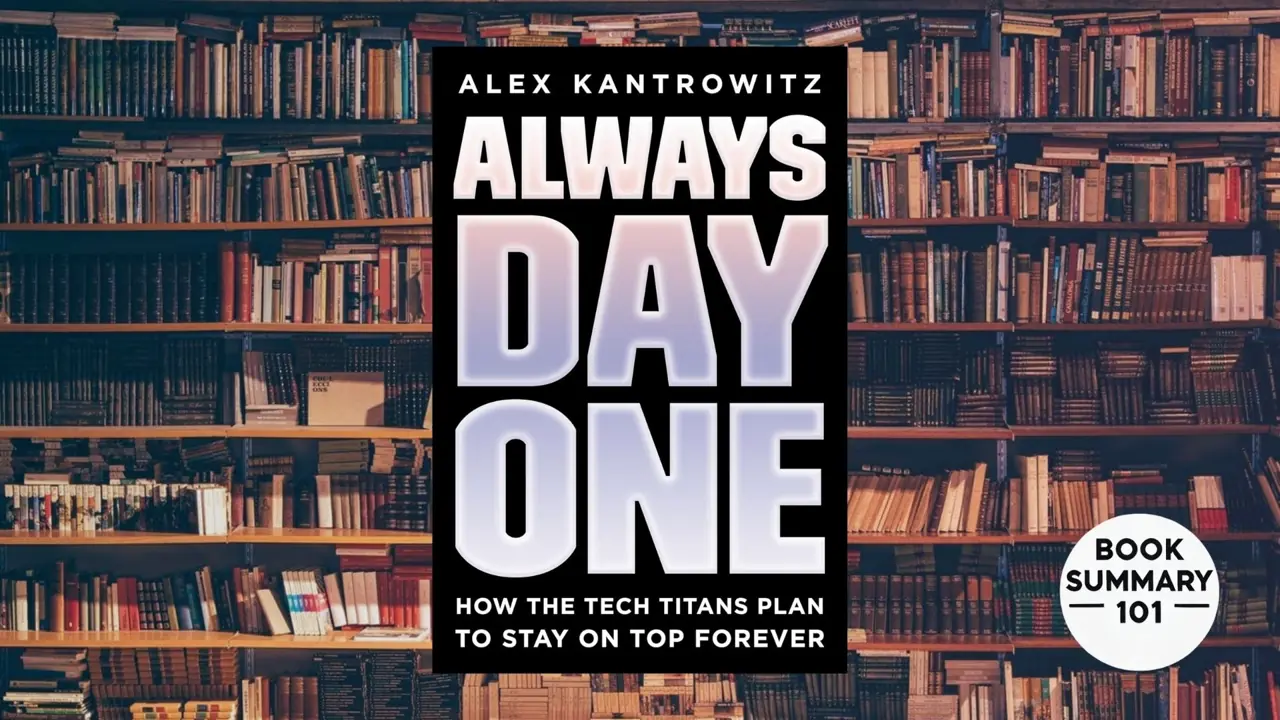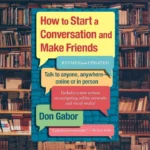Ever wondered how companies like Amazon, Google, and Facebook stay at the top of their game? They aren’t just riding the wave of success—they’re constantly reinventing themselves. In Alex Kantrowitz’s book Always Day One, he dives into the secrets of these tech giants and reveals how their mindset can inspire the rest of us. Here’s your ultimate guide to the book, broken down into relatable nuggets you can actually use in your own life and career.
Why Read This Book?
Let’s face it: the tech world moves faster than we can blink. If you’re someone who wants to stay relevant—whether as a professional, entrepreneur, or even as a curious observer—this book is your cheat sheet. Kantrowitz doesn’t just tell you what these companies do; he shows how they think and operate. It’s like getting a backstage pass to the secret sauce of innovation.
The Big Idea – What Does “Always Day One” Mean?
“Day One” is a philosophy championed by Amazon’s Jeff Bezos. The idea? Treat every day as if it’s your company’s first. It’s about staying scrappy, focused, and obsessed with innovation. On Day One, you’re still hungry, open to experimentation, and willing to make bold decisions. But on Day Two? That’s when complacency sets in—and as Bezos puts it, “Day Two is stasis. Followed by irrelevance. Followed by excruciating, painful decline.”
This mindset isn’t just Amazon’s secret. It’s what sets apart all the tech titans—companies like Google, Facebook, and Microsoft—who keep pushing boundaries while others fade away.
What Makes This Approach So Powerful?
What separates tech titans from the rest isn’t just their access to resources or talent—it’s their ability to create systems and cultures that enable constant reinvention. They’ve mastered the art of combining bold ideas with the practical means to bring them to life. Let’s dive deeper into how these principles work and why they’re so effective.
Flat Hierarchies – Everyone Has a Voice
In most organizations, great ideas can get buried under layers of management. But tech giants like Google and Amazon flip this dynamic. They create environments where the best ideas—no matter where they come from—can rise to the top.
For example, at Google, employees participate in brainstorming sessions called “Design Sprints,” where they work alongside colleagues from different departments to tackle big challenges. It doesn’t matter if you’re an intern or a senior engineer; your ideas are equally considered. This openness fosters creativity and gives employees a sense of ownership, leading to better outcomes.
How you can apply this:
- Encourage open dialogue. In meetings, make space for quieter voices to share their thoughts.
- Recognize contributions. Acknowledge great ideas, no matter who brings them forward, to build confidence and trust.
- Remove unnecessary barriers. Simplify approval processes to let ideas move quickly from concept to execution.
Open Collaboration – Sharing for the Greater Good
Collaboration isn’t just a buzzword for tech companies—it’s a strategic advantage. At Amazon, employees create tools not just for their own teams but for everyone in the organization. This “shared resource” mindset means no one is reinventing the wheel.
Consider Amazon’s internal tool-building system. If one team develops a way to automate warehouse operations, that tool is made accessible to all other teams. This accelerates progress and ensures everyone benefits from innovation. It’s like crowdsourcing ideas and solutions internally—resulting in a faster, more efficient organization.
How you can apply this:
- Share your knowledge. Got a process that works? Document it and share it with your peers.
- Build shared resources. Create templates, tools, or guides that others in your organization can use.
- Think beyond silos. Break down walls between departments to encourage collaboration and cross-pollination of ideas.
Automation Over Repetition – Freeing Up Creativity
A standout characteristic of companies like Amazon is their relentless focus on automation. They don’t waste employee talent on tasks that machines can do better. Instead, they free up their teams to focus on more strategic, creative work.
Take Amazon’s Alexa as an example. What started as a voice assistant for consumers also became a tool to reduce customer service workloads. By automating common queries, Amazon saves time for employees to tackle more complex issues—and gather data that fuels even greater innovation.
How you can apply this:
- Identify repetitive tasks. Look at your day-to-day work and ask, “Can this be automated?”
- Leverage tools. Use platforms like Zapier, Airtable, or Slack integrations to streamline workflows.
- Invest in skill-building. Once repetitive work is automated, focus on developing creative or strategic skills that add more value to your role.
Fearless Experimentation – Embrace the “Moonshots”
Google’s famous “Moonshot Factory,” X, is a breeding ground for big, ambitious projects that might sound crazy—until they work. From self-driving cars (Waymo) to internet-delivering balloons (Project Loon), Google invests in ideas that push the boundaries of what’s possible.
But here’s the catch: Not every idea succeeds. And that’s okay. X operates with the understanding that failure is a natural part of innovation. In fact, employees are rewarded for killing ideas early if they recognize they’re not viable, saving time and resources for the next big experiment.
How you can apply this:
- Take calculated risks. Don’t be afraid to pitch bold ideas, even if they seem out there.
- Learn from failure. Treat mistakes as opportunities to grow rather than setbacks.
- Create space for experimentation. Dedicate a portion of your time or budget to exploring new, unproven concepts.
Bureaucracy Is the Enemy – Stay Nimble
Large organizations often get bogged down by red tape, but tech titans deliberately structure themselves to stay nimble. They fight bureaucracy by empowering small, autonomous teams to act quickly and decisively.
At Amazon, this is called the “Two-Pizza Team” rule: Teams should be small enough to be fed with just two pizzas. This keeps communication clear and decision-making swift. By decentralizing authority, Amazon avoids the slow grind of approvals and allows innovation to happen in real-time.
How you can apply this:
- Simplify decision-making. Reduce the number of layers involved in approvals.
- Keep teams small. Work with lean groups to maintain focus and agility.
- Trust your team. Give people the autonomy to make decisions without micromanagement.
Real Examples
1. Amazon’s Automation Playbook
At Amazon, employees don’t spend their time doing repetitive, manual tasks. Instead, they build tools to automate those tasks. Think about Alexa: It wasn’t just a cool gadget but also a way to streamline customer interactions and gather tons of data. This frees up Amazon employees to focus on bigger-picture ideas.
2. Facebook’s Reinvention Machine
Even with over 3 billion users, Facebook acts like a startup. How? By constantly tinkering and questioning. For instance, when Instagram Stories started eating into Facebook’s engagement, the company didn’t panic. Instead, they adopted Instagram Stories’ best features and integrated them into their own apps. Adapt or die—it’s that simple.
3. Google’s Culture of “Moonshots”
Google has an entire division, X (the Moonshot Factory), dedicated to tackling wild ideas that might seem impossible. Self-driving cars, internet balloons, and AI breakthroughs? All born from this culture of fearless experimentation.
Why This Approach Works for Everyone
The magic of these strategies is that they’re not exclusive to tech giants. Any team, business, or individual can adopt elements of these approaches. Whether it’s fostering a culture of openness, embracing automation, or taking bold risks, these principles can transform how you work and innovate.
The key takeaway? Success isn’t about staying the same; it’s about staying adaptable. By embedding these habits into your routine, you’ll be better prepared for whatever challenges—or opportunities—come your way.
Why It Matters for YOU
Here’s the kicker: This book isn’t just about tech giants. It’s a wake-up call for all of us. The world is changing faster than ever, and staying relevant means adopting an “Always Day One” mindset in our own lives.
Whether you’re leading a team, launching a side hustle, or just navigating your career, think about:
- What’s holding you back? Are there repetitive tasks you could automate?
- Are you bold enough? How often do you try something new, even if it’s risky?
- Are you collaborating effectively? Are you sharing ideas and tools with your peers?
Join the Conversation!
What do you think about the “Always Day One” philosophy? Does it inspire you, or do you see challenges in applying it to your own life? Let’s talk! Drop your thoughts below—because who knows, your next big idea could be a game-changer.
5 powerful quotes from Always Day One by Alex Kantrowitz
1. “In Day One, there’s always more to build. In Day Two, there’s always more to protect.”
— A reflection on the danger of slipping into comfort and stagnation.
This quote explains why tech companies fight to stay in a Day One mindset—because the moment they get comfortable, they start focusing on preservation instead of progress.
2. “The companies that win tomorrow will be the ones that make invention part of their daily work.”
— The core message of the book, loud and clear.
Kantrowitz reminds us that continuous innovation isn’t just a special event—it’s a daily practice embedded into culture and workflow.
3. “Automation isn’t about eliminating jobs; it’s about making space for better work.”
— Challenging the usual fear around tech and automation.
Tech giants see automation not as a threat to employees, but as a way to unlock their creativity and problem-solving potential.
4. “A culture that listens beats a culture that commands.”
— Leadership lesson, tech edition.
The most successful companies give employees a voice and actively listen to their input—because the best ideas often come from the ground floor.
5. “Tech titans don’t cling to what worked yesterday. They ask: What’s next?”
— A powerful call to action for businesses and individuals alike.
Staying relevant means letting go of ego, comfort, and outdated practices—and leaning into curiosity and change.


